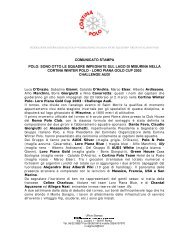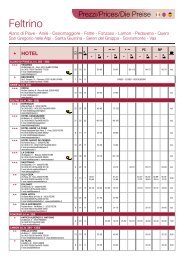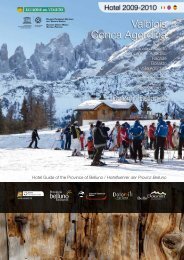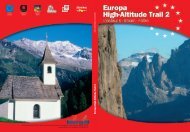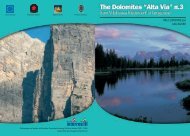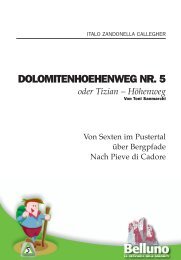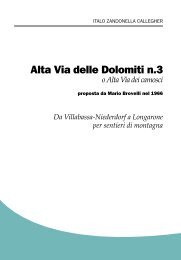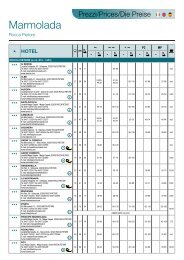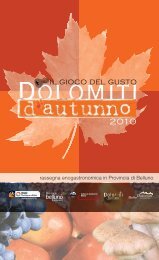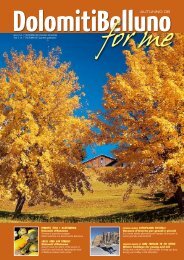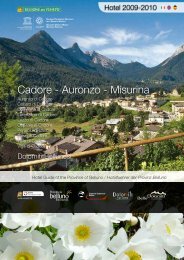IN THE HOMELAND OF TITIAN - Dolomiti
IN THE HOMELAND OF TITIAN - Dolomiti
IN THE HOMELAND OF TITIAN - Dolomiti
Create successful ePaper yourself
Turn your PDF publications into a flip-book with our unique Google optimized e-Paper software.
S. Leonardo, famous<br />
for the spectacular,<br />
unforgettable views<br />
it offers. The next<br />
stage on the route is<br />
Dosoledo, one of<br />
the most interesting<br />
examples of a<br />
“reconstructed” village,<br />
with a compact<br />
group of stone houses<br />
built around the square with its Neoclassical<br />
Church of S. Rocco and S. Osvaldo, built according<br />
to a design by Segusini, with the characteristic<br />
bulb-shaped bell tower and inside a wooden<br />
altarpiece by Brustolon(•2 and •3). The most<br />
characteristic feature of the village, however, is<br />
the large number of 19th •3<br />
century haysheds which<br />
enclose the village in a circle shape off towards<br />
the valley. Before reaching Santo Stefano, it is<br />
worth stopping off at the following villages: Padola,<br />
the first village to be entirely rebuilt during<br />
the reconstruction period by the Feltre architect<br />
Segusini, with its Parish Church of S. Luca;<br />
and Danta di Cadore, where, in the Church of<br />
San Rocco and San Sebastiano, you can admire a<br />
work attributed to Francesco Vecellio: Madonna<br />
con Bambino e i SS. Rocco e Sebastiano.<br />
The museums<br />
• Comelico Superiore<br />
Historical and Ethnographical Museum of the Customs<br />
and Traditions of Casamazzagno - tel. 04 5 67 49<br />
• Padola<br />
Museum of Alpine Culture, inside which is a large fresco<br />
by Vico Calabrò - tel. 04 5 67 49<br />
• Sappada<br />
War Museum, House-Museum of Country Civilization<br />
and Ethnographical Museum. - tel. 04 5 469 6<br />
•4<br />
Santo Stefano di Cadore (•4), the capital<br />
town of the Comelico area, is the last stage on<br />
this itinerary. It is the most important town in<br />
the whole valley, set in a green basin of fields and<br />
woodland at the confluence of the Padola Torrent<br />
and the Piave River, surrounded by striking<br />
Dolomite peaks. In the large square in the centre<br />
of the town is the Parish Church of Santo Stefano,<br />
the existence of which is documented as far back<br />
as the 3 rd century; considered the “mother” of all<br />
the churches in the Comelico, it was completely<br />
rebuilt in the 17 th century.<br />
santo stefano di Cadore Tourist information office<br />
tel. 04 5 6 0 – santostefano@infodolomiti.it<br />
sappada Tourist information office<br />
tel. 04 5 469 – sappada@infodolomiti.it<br />
SAPPAdA<br />
Just a few kilometres<br />
•5<br />
from San Pietro di<br />
Cadore is Sappada, or<br />
“Plodn” in the ancient<br />
language spoken locally;<br />
for this is a German<br />
dialect speaking island<br />
founded, it seems, a-<br />
round the year 000 by<br />
refugees from the Tyrol,<br />
perhaps attracted here<br />
by the rich mineral<br />
deposits. In the 5<br />
neighbourhoods which<br />
make up Sappada, the<br />
locals still speak German, or rather a Bavarian-<br />
Tyrolean dialect; a rare example of how tradition,<br />
architecture and language itself can make up a<br />
valuable cultural heritage which can, indeed must,<br />
be preserved. The valley is spread out over 5km<br />
along the flow of the Piave River, and one of the<br />
many splendid walks to be enjoyed in the area starts<br />
out at the Piave springs, in the Val Sesis (•5). This<br />
short route, about 8 km long, can be followed on<br />
foot, by car, by mountain bike or on horseback.<br />
Itinerary “The green countryside of Comelico„<br />
5



